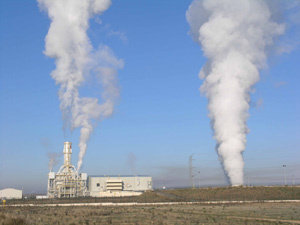The Supreme Court reasserts those calling for the cessation of the Castejón thermal power plant
- 14 years ago, authorization was granted for the implementation of the second group of the Elerebro plant. Still the neighbours of Castejón, together with the Subai Erakuntza Foundation, are still in conflict for justice to be done, without the support of the administrations of Navarra. The High Court of Justice of Madrid has given them the reason in a new judicial judgment. The power plant, which operates without authorization, is at the base of the new electricity line intended to overflow Castejón de Navarra to the Sea of Gipuzkoa.

The Subai Erakuntza Foundation has reported:
The Supreme Court has issued a new judgment on the judgment handed down by the High Court of Justice in Madrid. At the time, the High Court of Justice of Madrid declared the judgment that annulled the authorisation for the establishment of the plant and therefore did not request anything to implement that judgment. Despite the fact that in 2013 the same Court revoked the authorisation, the Court took into account that in 2012 it validated the administrative authorisation granted by the Ministry of Energy in 2005. In this way, the Administration wanted to resolve the authorization that the Court was to revoke.
In the new judgment of 19 March 2019, the Supreme Court considers that this validation is directly related to compliance with the judgment that annulled the authorisation. It therefore returns the case to the Madrid High Court of Justice and obliges it to issue a judgment on two issues: on the one hand, whether the judgment annulled the authorisation was executed or not; on the other hand, whether the validation had been carried out in order to save an authorisation that was about to be revoked, with the procedure still open.
14 years ago, authorization was granted for the implementation of the second group of the Elerebro plant. Still, the neighbours of Castejón, together with the Subai Erakuntza Foundation, are still in conflict for justice to be done, without the support of the administrations of Navarra. The 2013 judgment of the Madrid High Court of Justice clearly indicated that the second group of the plant did not comply with the environmental legislation in force at the time. The Supreme Court itself confirmed this judgment in 2016. Authorisation has been declared illegal twice. “However,” says Subai Erakuntza, the State Administration has done a great deal to maintain illegality. In the meantime, the Government of Navarra is still looking the other way, as it has done so far. This is the second time that the Supreme Court has supported the Subai Foundation. What does the Government of Navarra need to paralyse the operation of the plant? ".
It should be noted that these thermal plants at Castejón are the source of the 400 kV power line between Castejón and Muruarte. At the moment, it is intended to extend this line to Itsaso in Gipuzkoa. The aim of this line, as has been said this week, is to export to France electricity from this and another plant.
Joan den urrian eman zuen Espainiako Auzitegi Gorenak Elerebro enpresak Castejónen dituen bi zentral termikoetako bat ixteko epai irmoa, baina ez da oraindik bete, hainbat gizarte taldek eta gaia daramaten abokatuek prentsaurreko bidez salatu dutenez. Horrenbestez, lanean... [+]
Zentrala hirigunetik 2.000 metro baino gutxiagora dagoela eta ilegala dela berretsi du epaileak. 2007an eraiki zuten ziklo konbinatuko zentral termikoa itxi egin beharko du Elerebro enpresak.
Aurreikusitakotik oso behera dago Castejongo zentral termikoen funtzionamendua. Eskari falta dela eta, apenas ari diren erabilera orduak pilatzen.
Espainiako Auzitegi Gorenak Castejongo (Nafarroa) Elebro enpresaren bigarren talde elektrikoaren jarduera legezkoa ez dela erabaki du. Izan ere, udalerria eta enpresaren arteko distantzia 500 metrokoa da, legez bi kilometrotara egon behar lukenean.
Gara egunkariak Jesus Mari Tomasekin egindako elkarrizketa dakar gaur. Ribera + Centrales No (Erriberan zentral gehiagorik ez) plataformako kidea da Tomas. Dioenez, Nafar Gobernuak arau bat aldatu du legez kanpokotzat joa izan den proiektu bat aurrera atera ahal izateko... [+]














